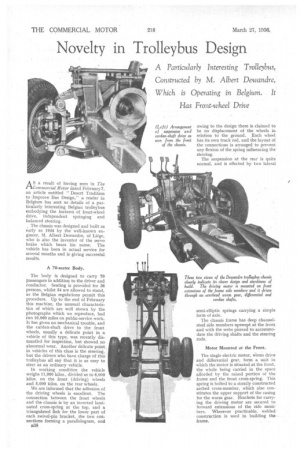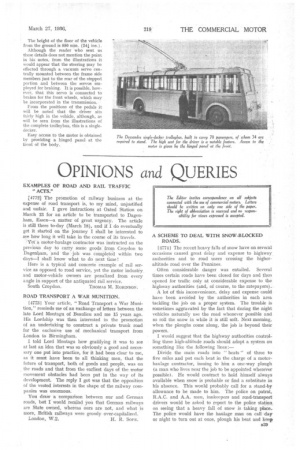Novelty in Trolley bus Design A S a result of having
Page 52

Page 53

If you've noticed an error in this article please click here to report it so we can fix it.
seen in The Commercial Motor dated February 7, an article entitled ". Desert Tradition to Improve Bus Design," a reader in Belgium has sent us details of a particularly interesting Belgian troLleylaus embodying the features of front-wheel drive, independent springing and balanced steering.
The chassis was designed and built as early as 1934 by the well-known engineer, M. Albert Dewandre, of Liege, who is also the inventor of the servo brake which bears. his name. The vehicle has been in actual service for several months and is giving successful results.
A 70-seater Body.
The body is designed to carry 70 passengers in addition to the driver and conductor. Seating is provided for 36 persons, whilst 34 are allowed to stand, as the Belgian regulations permit this procedure, Up to the end of February this machine, the unusual characteristics of which are well shown by the photographs which we reproduce, had run 10,000 miles on public-service work. It has given no mechanical trouble, and the cardan-shaft drive to the front wheels, usually a delicate point in a vehicle of this type, was recently dismantled for inspection, but showed no abnormal wear. Another delicate point_ in vehicles of this class is the steering, but the drivers who have charge of this: trolleybus all say that it is as easy to steer as an ordinary vehicle.
In working condition the vehicle weighs 11,000 kilos., divided as to 6,000 kilos. on the front (driving) wheels and 5,000 kilos. on the rear vheels.
We are informed that the adhesion of the driving wheels is excellent. The connection between the front wheels and the chassis is by an inverted laminated cross-spring at the top, and a triangulated link for the lower part of each swivel-pin bracket, the two COLSmations forming a parallelogram, and
owing to the design there is claimed to be no displacement of the wheels in relation to the ground. Each wheel has its own track rod, and the layout of the connections is arranged to prevent any flexion of the spring influencing the steering.
The suspension at the rear is quite normal, and is effected by two lateral semi-elliptic springs carrying a simple form of axle.
The chassis frame has deep channelsteel side members upswept at the front and with the webs pierced to accommodate the driving shafts and the steering rods.
Motor Mounted at the Front.
The single electric motor, worm drive and differential gear, form a unit in which the motor is situated at the front, the whole being carried in the space afforded by the raised portion of the frame and the front cross-spring. This spring is bolted to a stoutly constructed arched cross-member, which also constitutes the upper support of the casing for the worm gear. Brackets for carrying the driving motor are secured to forward extensions of the side members. Wherever practicable, welded construction is used in building the frame.
The height of the door of the vehicle from the ground is 550 1Tusi. (24f ins.).
Although the reader who sent us these details does not mention the point in his notes, from the illustrations it would appear that the steering may be effected through a vacuum servo centrally mounted between the frame side members just to the rear of the stepped portion and between the servos employed for braking. It is possible, however, that this servo is connected to brakes for the front wheels, which may be incorporated in the transmission.
From the positions of the pedals it will be noted that the driver sits fairly high in the vehicle, although, as will be seen from the illustrations of the complete trolleybus, this is a singledecker.
Easy access to the motor is obtained by providing a hinged panel at the front of the body..




























































































